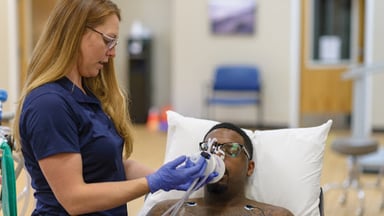 The Reeve Research team had an opportunity earlier this month to participate in a Neurotherapeutics Intermittent Hypoxia Workshop in Atlantic Beach, Florida. In recent years, a number of clinical and preclinical researchers have explored acute intermittent hypoxia (AIH), or periodically providing an individual with brief bouts of low oxygen, as a way to jump start plasticity in the spinal cord. This can lead to functional improvements with task specific training, such as hand function (e.g. Trumbower et al 2017), locomotion (e.g. Hayes et al 2014 and Navarrete-Opazo et al 2017), and respiration (e.g. Dougherty et al 2018). This may even enhance corticospinal (brain->spinal cord) plasticity in humans (Christiansen et al 2018).
The Reeve Research team had an opportunity earlier this month to participate in a Neurotherapeutics Intermittent Hypoxia Workshop in Atlantic Beach, Florida. In recent years, a number of clinical and preclinical researchers have explored acute intermittent hypoxia (AIH), or periodically providing an individual with brief bouts of low oxygen, as a way to jump start plasticity in the spinal cord. This can lead to functional improvements with task specific training, such as hand function (e.g. Trumbower et al 2017), locomotion (e.g. Hayes et al 2014 and Navarrete-Opazo et al 2017), and respiration (e.g. Dougherty et al 2018). This may even enhance corticospinal (brain->spinal cord) plasticity in humans (Christiansen et al 2018).
While we’re not sure all the ways AIH works, preclinical research suggests after chronic injury this is partially due to a brainstem serotonergic pathway that leads to enhanced BDNF (and other growth/trophic factor) release (e.g. Satriotomo et al 2016, Hassan et al 2018), which in turn leads to neuroprotection and activity-dependent plasticity in motor pathways. (If you want a deep dive into the complex neurochemical pathways, see Gonzalez-Rothi et al 2015). A competing non-serotonergic pathway that involves microglia and caffeine receptors may also play a role (see Navarrete-Opazo et al 2017b). When given repeatedly, AIH can lead to long lasting functional improvement, yet in rodents this effect is restricted to that task which the rodent trained after AIH (e.g. treadmill walking, ladder walking, reach & grasp tasks, see Prosser-Loose et al 2015).
The three-day AIH workshop focused on best practices, underlying mechanisms of AIH, and its effects on locomotion, skilled hand movement, and respiration after SCI. Perhaps the most promising part of this workshop was not the science, but the collaborative atmosphere of the pre-clinical and clinical researchers. This group split into workgroups towards the end of the meeting to explore strategies for progressing toward phase 3 clinical trials (including standardization of procedures and functional metrics, and improving trial design), prioritizing preclinical work exploring mechanisms of AIH that best supports and potentially improves clinical research, and trial design to look at combination therapies with AIH. One outcome is the establishment of an ongoing clinical trial workgroup, to improve standardization and communication between the handful of sites doing AIH clinical research. There was also a robust discussion of adaptive trial design and rigorous statistical approaches for clinical research with a heterogeneous population, such as the SCI community.
AIH looks really promising for the chronic SCI human population, but a word of caution, too much hypoxia is still a bad thing, so please don’t try this at home. As researchers are optimizing AIH parameters and protocols, and looking into factors that make this a more useful therapeutic for some with SCI than others, if you would like to participate in AIH research, you can find an ongoing clinical trial here.
You can also check out the detailed tweets from the workshop here: https://twitter.com/UFBreathe

